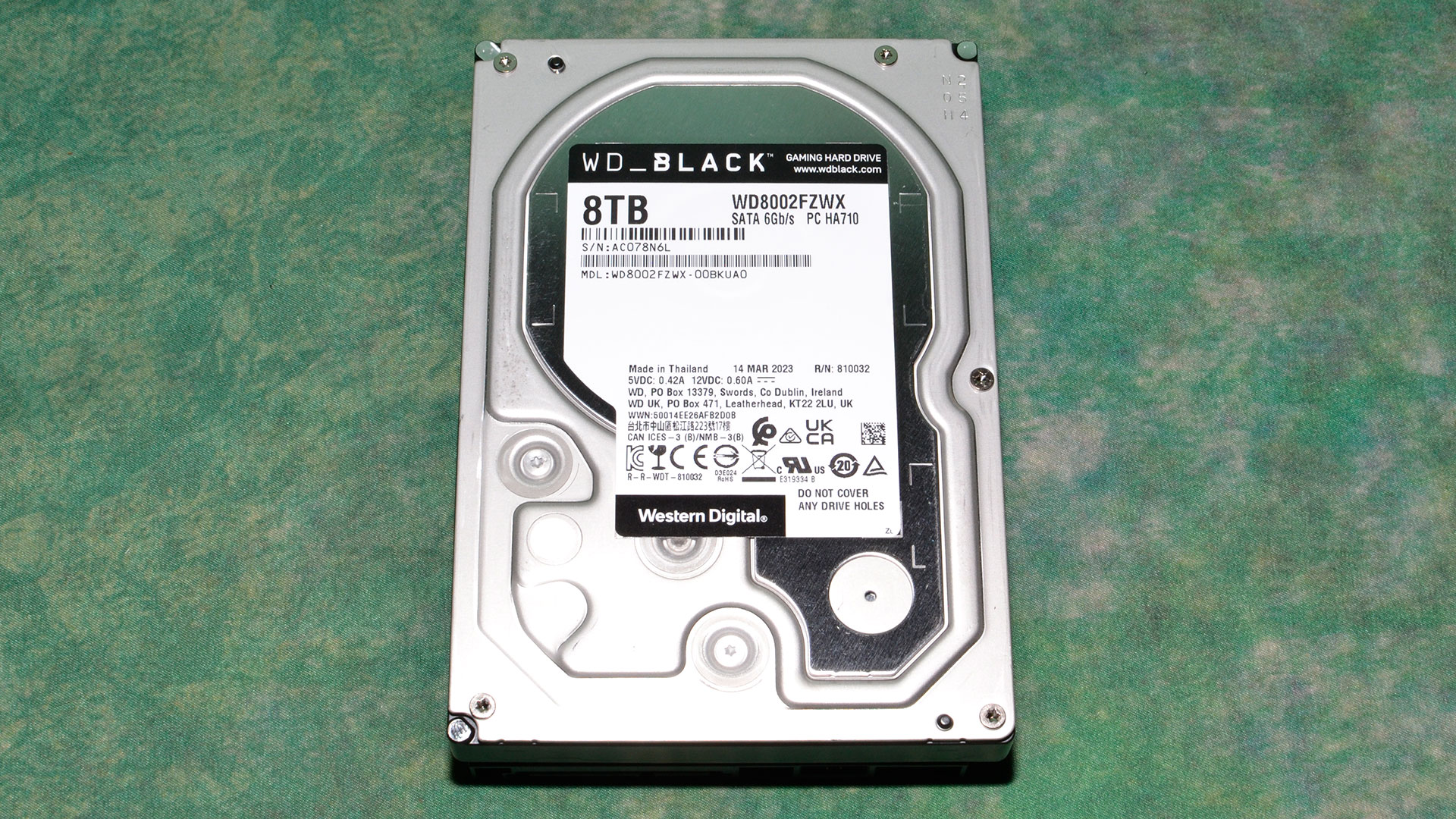Tom's Hardware Verdict
The WD Black HDD has mediocre performance, and the pricing is hard to swallow. It does have WD’s full warranty and would work well for a budget gaming or storage drive, but the WD Blue is the better bet if you're looking to add storage capacity.
Pros
- +
WD warranty and support
Cons
- -
Pricing
- -
Inefficient
- -
Aside from 3DMark, performance is underwhelming
Why you can trust Tom's Hardware
The WD Black is supposed to be the pinnacle of consumer hard drives and resides above the WD Blue in WD's product stack, but things aren't always what they seem. That can be particularly true with storage products with differing types of componentry yet come with the same name. For instance, the 8TB WD Black we have in for review comes with less DRAM cache and a lower sustained transfer speed than another version of the drive that has the exact same 8TB WD Black naming, sticker, and branding — the model number is the only way to tell the difference between the two drives.
Our 8TB WD Black also has a smaller DRAM cache and a lower sustained transfer speed than Seagate's top-end FireCuda, so it’s not expected to go toe-to-toe with the competing flagship. However, it is still part of WD’s Black lineup, which is steeped in a reputation for being a high-performance brand, and current pricing puts it in the FireCuda’s crosshairs. That's not to mention the prominent "Gaming" branding emblazoned in the Black's product description, which also exposes the drive to competition from much faster SSDs.
However, while the faster Seagate FireCuda only comes in 4TB and 8TB flavors, the WD Black does offer a wider range of capacities, including a 10TB option, which works in its favor. Still, WD needs to also distance this drive from its own WD Blue HDD line, which is a tough drive to beat in terms of bang for your buck.
Let's see how the Black stacks up.
Specifications
| Product | Western Digital Black HDD |
| Capacity | 8TB |
| Model # | WD8002FZWX |
| Pricing | $174.99 |
| Cost per TB | $21.87 |
| Interface | SATA 6 Gb/s |
| Form Factor | 3.5" |
| Technology | CMR |
| RPM | 7200 |
| Sustained Transfer Rate | Up to 238 MB/s |
| Cache | 128MB |
| Operating Power | 8.7W |
| Noise | 34 dBA |
| Workload Rate Limit | N/A |
| MTBF | N/A |
| Warranty | 5-Year |
The 8TB WD Black hard drive costs $174.99, or about 22 cents a GB, which is almost $15 cheaper than the 8TB Seagate FireCuda at the time of review. Pricing for consumer hard drives has been volatile, so it’s worth waiting for the right price. The FireCuda was significantly cheaper when we reviewed it recently, but the closer price now makes this more of a competition.
The WD8002FZWX 8TB Black uses CMR technology at 7200 RPM but with a smaller 128MB cache and a sustained transfer rate of just 238 MB/s compared to the Seagate FireCuda’s 260 MB/s.
The Black does have a WD8001FZBX version with a 256MB cache and better performance at up to 263 MB/s, but this model is more difficult to find and generally more expensive.
The WD Black is available in various capacities, from 500GB to 10TB, making it much more flexible than the 4TB/8TB FireCuda. Both drives come with a five-year warranty, although Seagate does include a three-year data recovery service.
This particular Black has the same 128MB cache as the WD Blue, but the Blue’s paltry two-year warranty is a big drawback if you’re weighing these two drives. Also worth consideration is the price difference, as the Blue is currently $60 less at the 8TB capacity point. It’s probably not worth the premium if you’re just looking for extra space, and avoiding the slower SMR technology of the BarraCuda is an easy decision.
Software and Accessories
Like with the WD Blue HDD, the Black will work with WD’s downloadable applications. This includes the WD Edition of Acronis True Image for imaging and cloning and also the Western Digital Dashboard, which is useful for health monitoring and updates. This is comparable to what Seagate offers with its hard drives.
Get Tom's Hardware's best news and in-depth reviews, straight to your inbox.
A Closer Look




The WD Black has a basic, stoic appearance, the black coloring on parts of the label giving it branding distinction from the WD Blue. The Black is intended to be the high-performance line of consumer hard drives, while the Blue is more entry-level. In this case, the primary difference is the spindle rate — 5640 RPM for the 8TB Blue, against 7200 RPM for the Black. The Blue has higher latency and a lower sustained transfer rate as a result, although it also takes less power and makes less noise.
MORE: Best Hard Drives
MORE: Best SSDs
MORE: How We Test HDDs And SSDs

Shane Downing is a Freelance Reviewer for Tom’s Hardware US, covering consumer storage hardware.